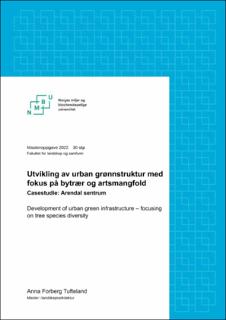| dc.contributor.advisor | Sebastian-Rivera, Agustin | |
| dc.contributor.author | Tufteland, Anna Forberg | |
| dc.coverage.spatial | Norway, Agder, Arendal | en_US |
| dc.date.accessioned | 2022-08-23T10:26:03Z | |
| dc.date.available | 2022-08-23T10:26:03Z | |
| dc.date.issued | 2022 | |
| dc.identifier.uri | https://hdl.handle.net/11250/3013051 | |
| dc.description.abstract | Denne oppgaven ser på videreutvikling av grønnstruktur i et urbant miljø med
sørlandsbyen Arendal som casestudie. Arendal sentrum har flere grå byrom
med uklare funksjoner, deriblant arealer med attraktiv og sentral beliggenhet
i nærhet til sjøen som i dag er utformet for bilisme. Noen av disse områdene er
avviklet som parkeringsareal av kommunen og befinner seg i en mellomfase.
Som sentral del av oppgaven undersøkes det hvordan artsmangfoldet til
byens trær kan økes for å danne en mer robust og bærekraftig trebestand,
og for å skape mer variasjon i bybildet. Høsten 2021 ble det registrert 211
bytrær i Arendal sentrum, hvorav 72 % er lindetrær. Lind er generelt godt brukt
som bytre og har sterk forankring i Arendal, men siden prosentandelen er høy
forsøker oppgaven å svare på hvordan man kan skape mer variasjon i byen.
Basert på stedsanalyser og registreringer er det foreslått fire overordnede
strategier for videreutvikling av Arendals grønnstruktur: Styrke grønne kobling
(1), transformasjon av parkeringsarealer (2), tilgjengelighet og flerfunksjonalitet
(3) og variert vegetasjonsbruk (4). Strategiene er implementert i en
overordnet plan for Arendal sentrum. I tillegg til masterplan og grep for hele
området er det valgt ut tre sentrale og sjønære transformasjonsområder
for detaljprosjektering: Kittelsbukta, Gamle rådhusplass og Kløckers plass.
Planforslaget tar sikte på å skape gode møteplasser med en menneskelig
skala. Det er foreslått varierte treslag som tar utgangspunkt i analyser,
registeringer, Sjöman et al. (2012) sine kriterier for valg av treslag og inspirasjon
fra referanseprosjekter. Utformingen av de tre byrommene bidrar til å gi
sentrumsnære, grønne oppholdsrom for Arendals innbyggere, samt å skape
en attraktiv kystpromenade og øke kontakt mellom by og sjø. Som kystby kan
flere gode oppholdssteder i nærheten til sjøen forsterke Arendals identitet. | en_US |
| dc.description.abstract | This master’s thesis investigates on how green infrastructure can be developed and planned in an urban environment. Arendal, a coastal city in south of Norway, is used as case study. The city centre of Arendal has several urban spaces with unspecified functions, appearing rather empty and unused. Some of these spaces have attractive and central location by the coastline, but are programmed for cars and are lacking a human scale.
As a central part of the thesis, this paper seeks to examine the potential increase of species diversity of urban trees in Arendal. The aim is to create a healthy and sustainable urban tree population, as well as establish more variety in the cityscape. In fall of 2021, 211 urban trees were registered in the city centre of Arendal, of which 72 % were linden trees. Linden is in general a well-known tree in urban environments, and has strong roots in Arendal. However, since this is a high percentage, this paper provides a proposal on how a greater variety of urban tree species can be achieved.
Based on site analysis and registrations, four overall strategies have been proposed on how to further develop Arendal’s green infrastructure: Strengthening of green connections (1), transformation of parking areas (2), strengthening of accessibility and multifunctionality (3) and variation of vegetation (4). These strategies are implemented in a master plan for Arendal city centre. Three central transformation areas has been selected for detailed planning: Kittelsbukta, Gamle rådhusplass and Kløckers plass. The urban design aims to create good meeting spots with a human scale. Various types of urban trees have been proposed based on analysis, registrations, the criterias of Sjöman et al. (2012) in the selection of urban trees, and inspiration from reference projects. The design of the three project sites will contribute to attractive and central outdoor spaces for Arendal’s inhabitants. The sites all take part in a coastal walking promenade and increase contact between the city and the coastline. Attractive locations facing the sea also contribute to strengthen Arendal’s identity as a maritime city. | en_US |
| dc.language.iso | nob | en_US |
| dc.publisher | Norwegian University of Life Sciences, Ås | en_US |
| dc.rights | Attribution-NonCommercial-NoDerivatives 4.0 Internasjonal | * |
| dc.rights.uri | http://creativecommons.org/licenses/by-nc-nd/4.0/deed.no | * |
| dc.title | Utvikling av urban grønnstruktur med fokus på bytrær og artsmangfold : casestudie : Arendal sentrum | en_US |
| dc.title.alternative | Development of urban green infrastructure : focusing on tree species diversity | en_US |
| dc.type | Master thesis | en_US |
| dc.description.localcode | M-LA | en_US |

